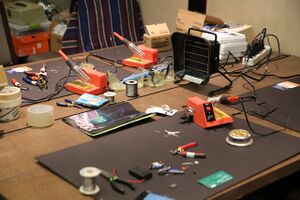Resource:How to engage the campus community in the design of a makerspace
A makerspace can provide a social and creative outlet that brings together a campus community. Many schools are enthusiastic about the possibility of a makerspace, but the logistics of designing one can be intimidating. Each location presents its own set of needs, resources, and challenges. This article describes the process of designing a community-focused makerspace using insights shared by Brad Turner.
Contents
Filling Needs and Setting Goals
When designing a makerspace, you should consider the needs it can meet. A UIF Landscape Canvas may be helpful for assessing the gaps present on campus and the tools that may
be used to fill them. These gaps can also be identified through observations made during day-to-day school life as well as conversations with fellow students and faculty. If there is no particular target audience, it’s imperative that you get a variety of perspectives in order to objectively look at what the campus needs as a whole, rather than just your specific college or department.
After determining the needs of your campus, goals should be set so you can meet the identified needs and determine which needs take precedence over others. Collaboration with students of all types and majors will help ensure that the needs are met. Additionally, it is important to have regular meetings when students can voice their opinions, share their ideas with fellow students, and offer a different perspective.
Faculty Support
Though it is beneficial to have a student-led makerspace, faculty support is crucial for the initiative to be launched and sustained. In the case where only one advisor is selected to oversee
the entire space, it may be helpful to choose someone with a passion for innovation over someone with great technical skills. An advisor’s role will largely be to consult with and advocate for the makerspace. Though it would be ideal for the advisor to know how to work the tools in the makerspace, the advisor will not likely need this kind of knowledge.
The implementation of a makerspace panel, with advisors from various disciplines and areas of the school, is an efficient and productive system used by schools such as Michigan Tech. The panel includes people from computer science to biology to engineering as well as people from facilities management and campus safety. A panel dynamic nurtures collaboration for decisions regarding the makerspace. Because the panel can have face-to-face meetings set at a predetermined time every month, this setup cuts down on seemingly infinite email strings of communication. The combination of perspectives from different areas of the school bring a fresh and productive dynamic to the makerspace.
Materials
Goals for the makerspace should include a vision for what kind of projects will occur in the space. Discussions regarding the tools needed for such projects should be open to university
personnel beyond the makerspace team. By getting outside opinions, you will be able to gauge the equipment needed for operation. Your makerspace may call for a metalworking area, a woodworking station, a 3-D printer, or something totally different. While considering the tangibles for the makerspace, keep in mind that organization and operation of any equipment should be addressed before asking for such equipment.
At this point you will also need to consider sustainability of the equipment. For instance, pipettes should be calibrated every six months. Make sure there are sufficient funds allocated to maintain equipment and purchase supplies to meet the demand of students.
Financial Support
A makerspace is a considerable investment, so securing financial support can be a challenge. Gaining faculty support is key to gaining administrative and financial support. After all, a
makerspace will likely be operated primarily by faculty and students. The need and support for a makerspace should be demonstrated, then the conversation can shift toward funding. Obtaining local company sponsorship in any way, particularly for tools and materials, is important to further convey enthusiasm for the makerspace. For example, Michigan Tech’s makerspace was given a large donation of equipment from Milwaukee Tool which included prototyping tables. The makerspace team then turned the table building into an event!
Access and Maintenance
The goals of the makerspace will include an audience that the makerspace will serve. Even a small makerspace can be made available to many students, but certain guidelines will need
to be in place. If the makerspace has any tools or equipment that require safety procedures, there should be a system for overseeing the makerspace during operational hours. Many schools successfully implement student leadership. Though faculty may volunteer assistance, the involvement of student leaders engages more people on campus and is often easier to coordinate. Each leader should be trained to use the equipment and encouraged to make all visiting makers feel welcome.
Academic Involvement
There are several possibilities for helping schools’ curriculums evolve to be more makerspace-friendly. This will increase awareness and engagement among students. There are several
foibles of trying to sway an entire department to use makerspaces in their department-wide curriculum; namely, the department as a whole is highly unlikely to make any dramatic changes. Instead, target individual professors or faculty members who are particularly interested in innovation. This is much like when a grassroots campaign aims to spur interest on a person-to-person basis. When coordinating with individual faculty members, it might be appropriate to suggest co-designing a single class with the professor as the professor may not know how their class could best utilize the space.
A makerspace phenomenon will not happen overnight. It will take a clear effort to spread awareness through the medium of class curriculum. Experience has shown that this is an effective method in introducing students to the resources available, and having more classes utilize the makerspace will increase both its visibility and use among students.
Activities and Events
Fun social events in a makerspace can be a low-pressure way to introduce people to the space. An example of this is a brewing-themed event during which coffee could be served and
people could decorate mugs and design bottle openers. These sorts of activities are fun to many different types of people.
Since it is important that a makerspace reflect the demographics on campus, it can be helpful to host makerspace events for underrepresented demographics. For example, hold a “Ladies Night” event to encourage the attendance of more women.
Partnering with other campus offices and groups can also lead to successful events. Some schools have partnered with their career center to bring in employers that would be interested meeting with innovative students.
Promoting and Making Connections
Makerspace student leaders are some of the best makerspace promotors. They invite their friends and peers to utilize and attend events in the space, and word of mouth leads to good
attendance. Diversity among makerspace student leaders may help encourage diversity of attendees.
It may also be useful for a group of students to form a marketing team or policy committee specifically for the makerspace. This connects students to the space on a personal level while providing the space with valuable contributions. A marketing team has the added bonus of advertising for the space around campus!
Additionally, faculty are a useful connection for promotion: students developing a makerspace can cater to the needs of a college by collaborating with the needs of faculty members. When a space is supported by many faculty, it is easier to build credibility and use resources across the entire campus.
Advice
1. Surround yourself with people who are passionate about what you are doing. These are the type of people you can call at 1:00 a.m. and know they’ll be there to help if something goes
wrong.
2. Pace yourselves and be careful not to fall into discouragement. Recognize that you are doing something amazing! Any amazing feat requires a lot of time and effort. You can’t start at zero and instantaneously be at 100%. Try to take your time and have fun with it.
3. Enjoy the little things and small victories along the way. Thank others for what they do and take some pride in what you were able to accomplish together.
Written By
Meg Anderson, Kathleen Baert, Jared Emerson, Allen Liu, Kiera Rust, James Setzer








